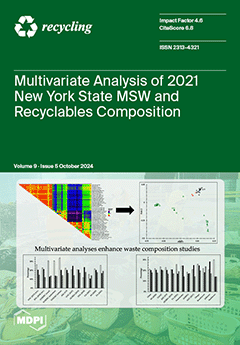Open AccessArticle
Composition of New York State (United States) Disposed Waste and Recyclables in 2021: An Advanced Analysis of Waste Sort Data
by
David J. Tonjes, Sameena Manzur, Yiyi Wang, Firman Firmansyah, Mohammad Rahman, Griffin Walker, Sera Lee, Tania Thomas, Matthew Johnston, Michelle Ly, Luis Medina, Randy Shi, Sagarika Srivastava, Clara C. Tucker, Htet Z. Maung, Krista L. Thyberg and Elizabeth Hewitt
Cited by 1 | Viewed by 3485
Abstract
Understanding the composition of disposed municipal solid waste (MSW) and recyclables can lead to better waste management. New York State (United States) has never had a state-wide waste characterization sorting program. In 2021, sampling was conducted at 11 locations, representing 25% of the
[...] Read more.
Understanding the composition of disposed municipal solid waste (MSW) and recyclables can lead to better waste management. New York State (United States) has never had a state-wide waste characterization sorting program. In 2021, sampling was conducted at 11 locations, representing 25% of the state population outside of New York City. Twenty-three tonnes from 173 discrete samples were sorted into 41 categories. The resulting data were analyzed by single constituent approaches and more novel multivariate distance techniques. The analyses found that disposed MSW was 22.8% paper, 20.5% food, and 16.8% plastics. Recyclable paper and glass–metal–plastic containers were 18.2% (11.7% paper, 6.5% containers) and yard waste was 6.5%, meaning about 25% of the disposed MSW could have been recovered. Multivariate analysis determined that the disposed MSW was similar to that from other United States jurisdictions such as Wisconsin, Pennsylvania, New York City, and Syracuse (NY), and different from California and United States Environmental Protection Agency model data. Recyclables composition was different from disposed MSW composition. Dual-stream recyclables were sorted better than single-stream recyclables. Corrugated cardboard was the most common paper recyclable and plastics were the most common container recyclable. The data are being used to help guide planning for an expected packaging extended producer responsibility law for the State.
Full article
►▼
Show Figures





